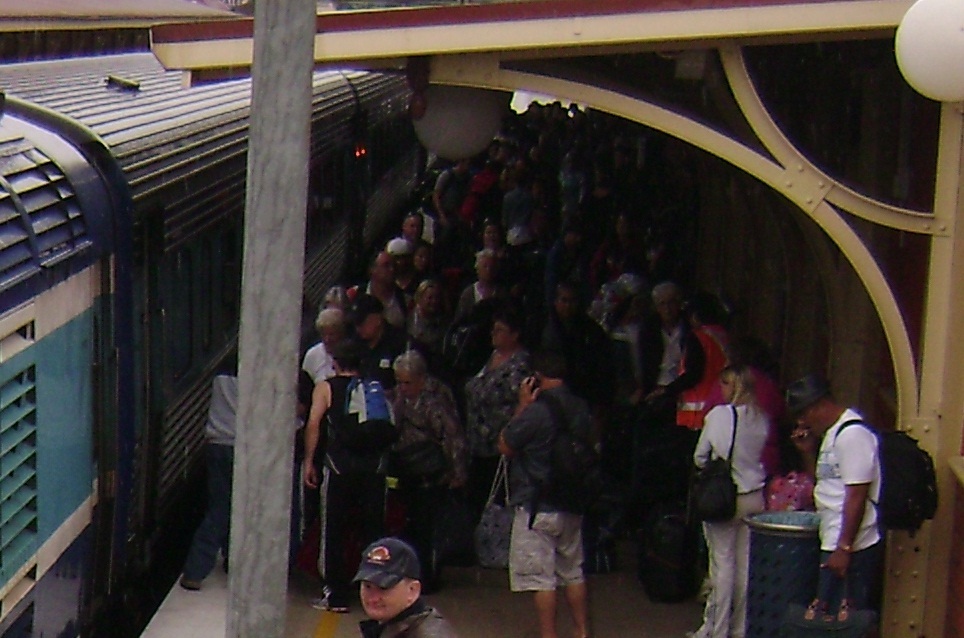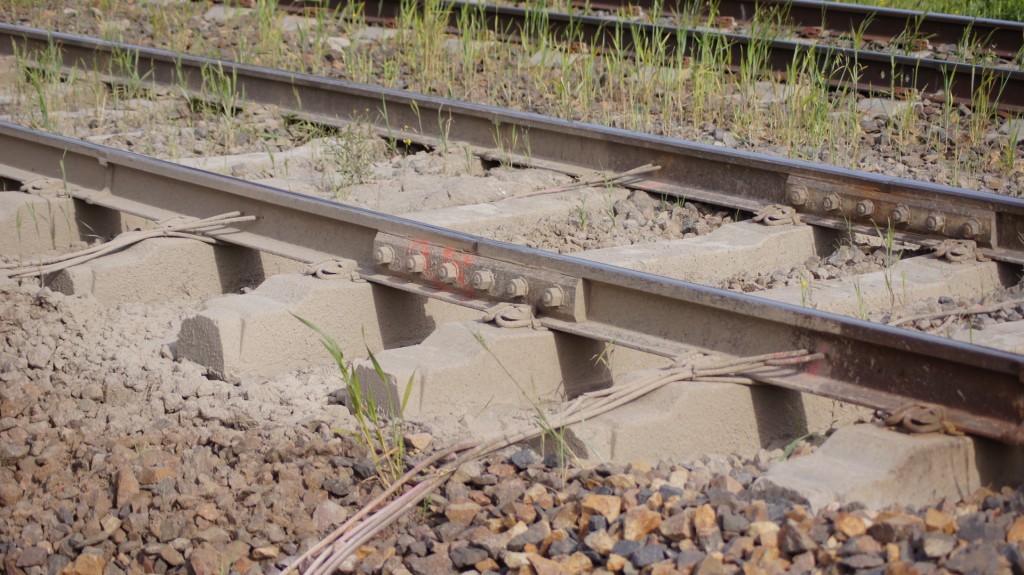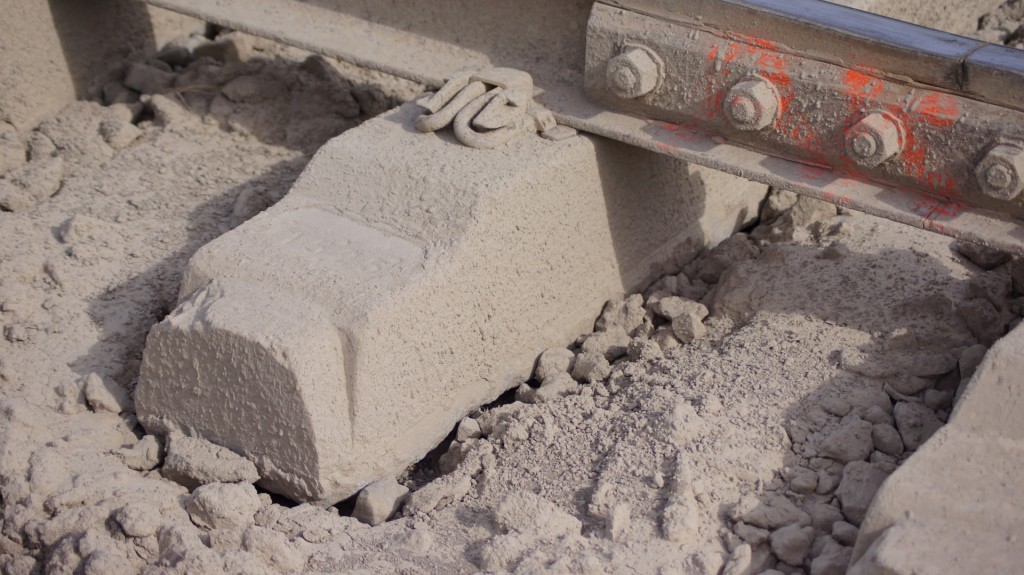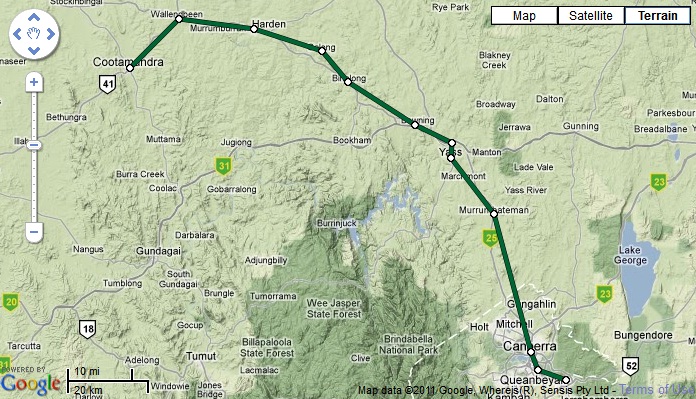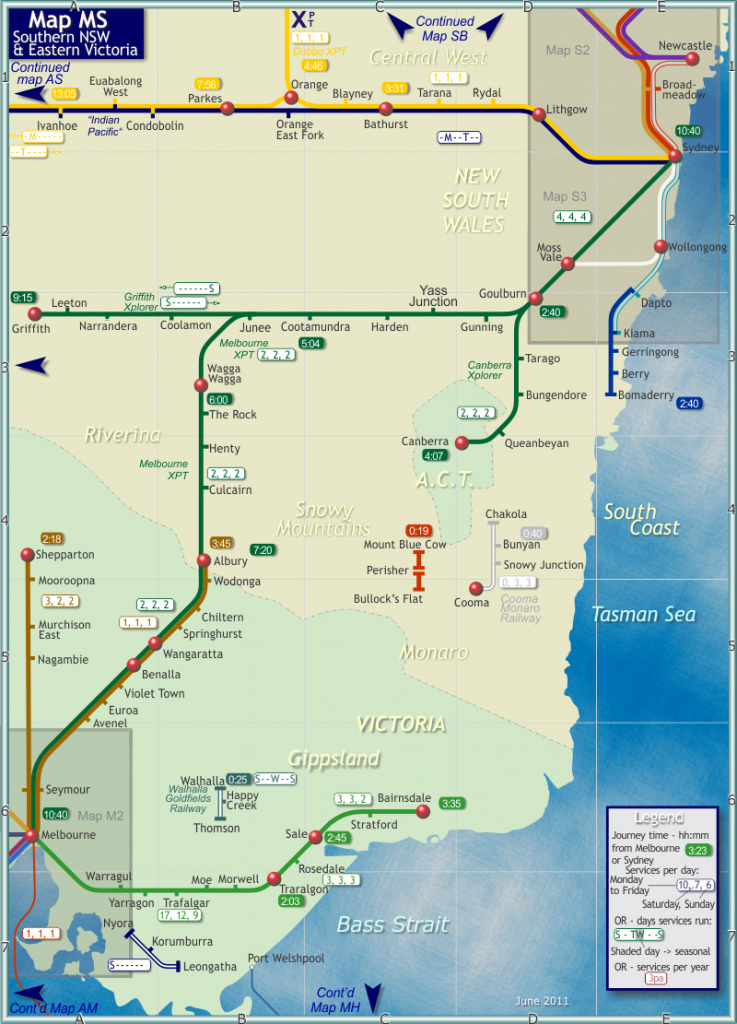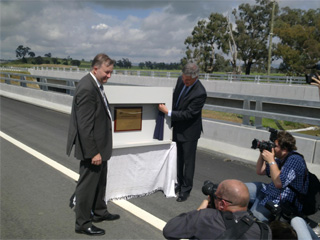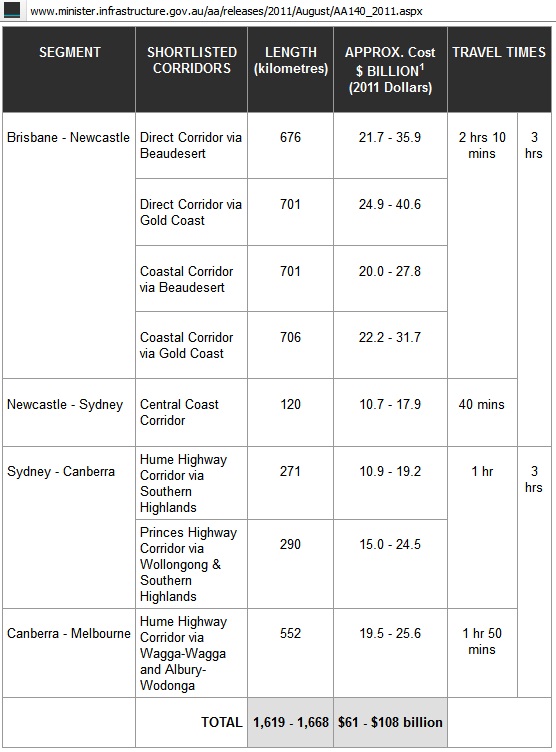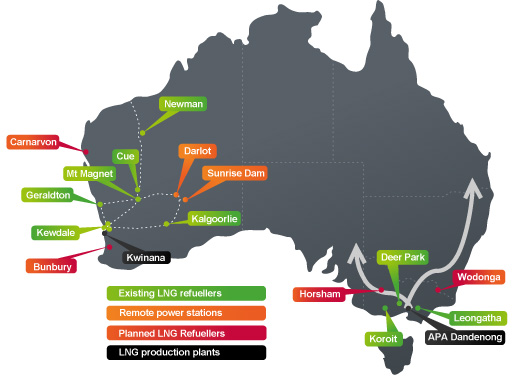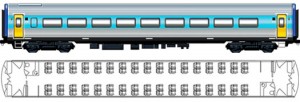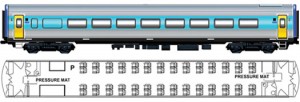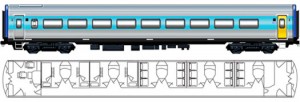On 22/11/2011 I tested the XPT train from Sydney to Melbourne on my way to the conference
Building Community Resilience and Minimising Risk
http://www.mav.asn.au/events/Pages/Building-Community-Resilience-and-Minimizing-Risk-23112011.aspx
organised by the Municipal Association of Victoria, for which I did a presentation titled, “7 years of peak oil”, available at the above link.
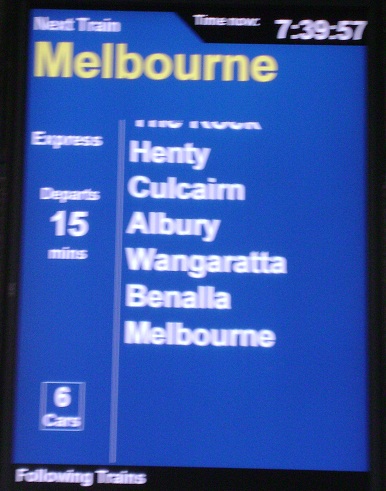 << Indicator board in Strathfield, a suburb in Sydney. Destination: Melbourne, 960 km from Sydney.
<< Indicator board in Strathfield, a suburb in Sydney. Destination: Melbourne, 960 km from Sydney.
The test failed. Departing from Strathfield 7:53 am, the train broke down 4 hrs into what is normally an 11 hr trip, shortly before Yass Junction
http://www.stationspast.net/nsw/main-south/yass-junction
http://en.wikipedia.org/wiki/CountryLink
in the middle of nowhere:
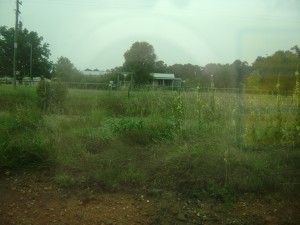 << “Old School House”, not “Southern Cross” in Melbourne, is where our train adventure ended abruptly.
<< “Old School House”, not “Southern Cross” in Melbourne, is where our train adventure ended abruptly.
This picture was taken out of the XPT right there where it broke down.
Passengers were informed there was a problem with air pressure. We stood there for 3 hrs, always told by staff about the progress, but there was none.
Passengers in car D, killing time. Many wandered around to find a spot where their mobile phone would work >>
The air conditioner stopped working but luckily it was a cloudy, rainy day so the train did not get too hot but it was getting stuffy. We all tried to ring on our mobile phones, but there was no network coverage (obviously mobile licensing never thought about providing coverage along the rail line). With all doors locked, you feel being trapped. A young fellow passenger beside me got upset, cursed the day he sat in this train and continuously murmured something about his stolen car. A young lady finally managed to find a spot in the train where she could phone and she contacted the police. It is documented in this news paper article in the Goulburn Post:
XPT passengers left stranded
BY LOUISE THROWER
25 Nov, 2011 09:09 AM
NEARLY 200 passengers on a Melbourne bound XPT were left stranded on tracks for up to four hours on Tuesday after the train’s brakes locked.
With only one toilet in use, air conditioning not working properly and people not allowed to leave the train, some distressed passengers called police for help.
Inspector John Sheehan said it was not a police matter and contacted rail authorities to clarify the situation. The train came to a halt at Jerrawa, between Gunning and Yass, at about 11.40am, some 80 minutes after leaving Goulburn.
http://www.goulburnpost.com.au/news/local/news/general/xpt-passengers-left-stranded/2370535.aspx
 Finally it was decided to move the train back to Goulburn, using the rear engine, travelling between 20 and 40 km/h, on the wrong side of the tracks, potentially holding up other trains. But there was not much freight traffic there on that day anyway, CountryLink lucky twice.
Finally it was decided to move the train back to Goulburn, using the rear engine, travelling between 20 and 40 km/h, on the wrong side of the tracks, potentially holding up other trains. But there was not much freight traffic there on that day anyway, CountryLink lucky twice.
In Goulburn, passengers crowded the platform under the roof as rain was pouring down and waited for buses, another hour gone.
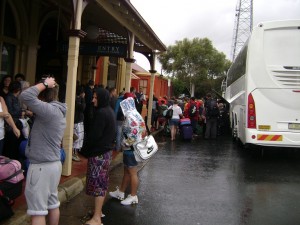 << passengers were divided into groups according to the destinations of each bus. I got bus #2, leaving Goulburn around 5 pm, with destinations in Victoria including Melbourne.
<< passengers were divided into groups according to the destinations of each bus. I got bus #2, leaving Goulburn around 5 pm, with destinations in Victoria including Melbourne.
The driver had to observe prescribed rest hours so we wasted another ¾ hr at a very interesting truckies’ stop.
Arrival in Melbourne 2 am next morning. A CountryLink representative who had come from Albury especially for us, a handful of passengers, led us into a hotel just 200 m from the Southern Cross Station. I had just 4 hrs sleep before taking a tram to the conference venue in Flemington. The old tram also developed technical problems. The driver had to go several times to a switch board at the rear of the tram. But after a couple of stops further down the line a maintenance crew entered the tram and fixed the fault. Compare that with NSW! Finally, at stop 29 “Flemington Racecourse” of tram 57, there was no proper and safe pedestrian crossing to get to the side of the racecourse and the Quest Hotel on Epsom Rd.
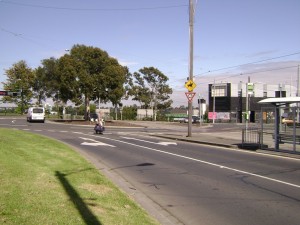 <<Participant in the MAV transition conference trying a simple transit across 2 car lanes without pedestrian crossing to reach the tram stop 29 from the Quest Hotel.
<<Participant in the MAV transition conference trying a simple transit across 2 car lanes without pedestrian crossing to reach the tram stop 29 from the Quest Hotel.
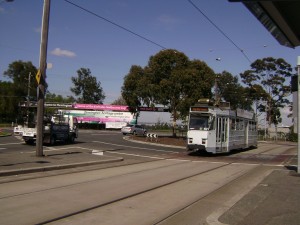 Although Melbourne’s trams offer excellent services, these old cars (seen here at stop 29 near the famous Flemington Racecourse) need to be replaced >>
Although Melbourne’s trams offer excellent services, these old cars (seen here at stop 29 near the famous Flemington Racecourse) need to be replaced >>
The back trip
Undeterred from the previous experience I took the XPT back to Sydney. This time the train was OK but it arrived late at platform 1 in Southern Cross and it also departed late. It accumulated a total of 1 hr 35 min delay over the whole trip, caused by many, many slow sections with speed limits due to bad track. This picture shows the problems, mud holes:
http://modelrail.otenko.com/australian-trains/yass-junction-october-2011
As a result of the late XPT arrival in Sydney I missed the last Metrobus 54 in Epping at 21:12 which forced me to take a taxi home.
And this ends the test report to get from Sydney to Melbourne without flying and without taking a taxi. It failed miserably.
Not only that. Nowhere did I see large scale track work with modern equipment which would do the track work speedily and commensurate with the size of the problem. The repairs seem to be done on the cheap and slowly.
These problems are not new.
Faulty tracks
27/9/2010
KERRY O’BRIEN, PRESENTER: Here is a story about the train drivers calling for an urgent inquiry into the condition of the main Sydney-Melbourne railway line, which they describe as “a disaster waiting to happen”.
http://www.abc.net.au/7.30/content/2010/s3023257.htm
Rough rail ride
6/4/2011
MATT PEACOCK, REPORTER: The XPT, or express passenger train, runs from Sydney to Melbourne and back twice a day. Lately, for its passengers, locals and tourists alike, this train is anything but an express.
http://www.abc.net.au/7.30/content/2011/s3184257.htm
Independent assessment for ARTC
http://www.artc.com.au/library/news_2011-04-06.pdf
The plan to save Australia’s busiest railway track
27/6/2011
LEIGH SALES, PRESENTER: A major maintenance program on the country’s busiest railway line is being fast-tracked after a warning that without it, parts of the track could turn to mud. Earlier this year, 7.30 reported that defects on nearly a third of the Melbourne to Sydney line had forced a blanket speed limit. Tonight, the Federal Government-owned Australian Rail Track Corporation reveals the radical steps it’s taking to fix the track. Here’s Matt Peacock.
http://www.abc.net.au/7.30/content/2011/s3250945.htm
Epilogue
Question: So what will happen when airlines go broke? While this story is written, American Airlines is in proceedings for chapter 11 bankruptcy protection.
http://mashwatch.com/news/30766/parent-of-american-airlines-files-for-bankruptcy/
See also this post:
30/10/2011 Qantas hit by invisible hand of peak oil
http://crudeoilpeak.info/qantas-hit-by-invisible-hand-of-peak-oil
Answer: There will be absolutely no alternative travel arrangements which could replace domestic flights. Definitely not the existing set of trains.
Hints for MPs travelling to and from Canberra
MPs are advised to acquaint themselves with the time table of buses connecting (or rather not connecting) to the XPT (note the bus travels parallel to the rail line up to Yass, half of the trip, which is of course slower)
Here is an example from Melbourne:
Southern Cross dep 8:30 by train
Cootamandra arr 14:37
Cootamandra dep 14:50 by bus
Canberra Civic arr 17:22
http://www.railmaps.com.au/routedetails.php?RouteSelect=294
http://www.railmaps.com.au/viceast.htm
What to do
(1) Priorities have to be shifted from road to rail, immediately
While rail repair work is excruciatingly slow, large scale work on the Hume Highway continues unabated and totally ignorant of peak oil.
http://www.rta.nsw.gov.au/roadprojects/projects/south_western_region/hume_hway_dup/index.html
The 2011/12 NSW budget contains $250 million for continued work on the Holbrook, Tarcutta and Woomargama bypasses
7/11/2011: Federal Transport Minister Albanese inaugurating the Woomergama bypass
http://www.greaterhume.nsw.gov.au/HumeHighwayBypasses.aspx
18/7/2008: Minister Albanese at Petersham Climate Change Forum:
“We cannot solve the problem of peak oil in 5 minutes tonight”
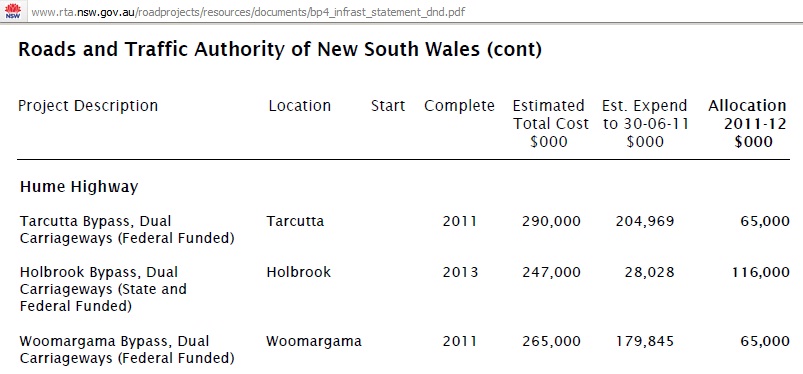 http://www.rta.nsw.gov.au/roadprojects/resources/documents/bp4_infrast_statement_dnd.pdf
http://www.rta.nsw.gov.au/roadprojects/resources/documents/bp4_infrast_statement_dnd.pdf
All these projects are counterproductive in relation to the post peak oil world and a total waste of funds as already mentioned in this post:
7/9/2011 NSW budget 2011/12 does not increase oil use productivity
http://crudeoilpeak.info/nsw-budget-2011_12-does-not-increase-oil-use-productivity
(2) High speed rail dreams
It is too late for HSR projects. Peak oil which started in 2005, has economic and financial consequences which limit infrastructure funds available to mitigate peak oil. The Hirsch report for the US Department of Energy http://en.wikipedia.org/wiki/Hirsch_report came to the conclusion that 10-20 years are needed to prepare for peak oil. That period has long passed.
http://www.minister.infrastructure.gov.au/aa/releases/2011/August/AA140_2011.aspx
High Speed Rail Study
The study is being conducted in two phases. Phase 1, undertaken between January and June 2011, has assessed the likely range of costs, identified potential corridors and stations, estimated the potential future market demand for HSR, and considered potential social and regional development impacts of a HSR network.
Phase 1 has not examined the financial feasibility of HSR on the east coast of Australia and therefore does not include a benefit versus cost analysis. Phase 2 will examine the financial feasibility of HSR, identify an optimum route alignment, refine patronage and cost estimates and investigate potential financing options.
The risk-adjusted cost estimate for the implementation of an overall HSR network [Brisbane-Melbourne] would fall within the range of $61 billion to $108 billion (in $2011) depending upon the combination of corridors selected, reflecting the level of confidence for this phase of the study.
Recommendation: It would be wiser to spend any further money of the $20 million set aside for the study towards buying new rolling stock for intercity rail services, for example sleeper cars.
http://crudeoilpeak.info/solutions/night-trains
(3) Emergency projects needed
Infrastructure Australia should immediately plan for how passenger and freight traffic between capital cities is to be organised when airlines go into receivership and when diesel shortages pop up following a big bang in the Middle East.
(a) Convert coaches to LNG (that will reduce space for luggage). See images here from a Chinese manufacturer:
http://www.alibaba.com/product-gs/236610714/LNG_bus_GTQ6950N3B3.html
(b) Convert diesel locos to LNG
http://crudeoilpeak.info/solutions/lng-locomotive-conversion
(c) Built-up of LNG supply network and refuelling stations
http://www.evollng.com.au/images/distmap-large.jpg
Related posts:
11/10/2011 Australia’s natural gas squandered in LNG exports
http://crudeoilpeak.info/australias-natural-gas-squandered-in-lng-exports
13/10/2011 NSW gas as transport fuel. Where are the plans?
http://crudeoilpeak.info/nsw-gas-as-transport-fuel-where-are-the-plans
Australia’s debating club on transport fantasies after global crude oil exports peaked in 2005
Capacities of XPT trains:
 21 seats 1st class, buffet & saloon
21 seats 1st class, buffet & saloon
http://www.countrylink.info/travelling_with_us/our_fleet/xpt
The standard 6 car XPT would for example have 3×68 + 22 + 56 + 18 = 300 seats, a 7 car set with two 1st class cars would have 356 seats
Compare that to an Airbus 321-200 with 213 seats. Let’s have a look at the BITRE statistics
 Data from: http://www.btre.gov.au/info.aspx?ResourceId=225&NodeId=101
Data from: http://www.btre.gov.au/info.aspx?ResourceId=225&NodeId=101
So we have appr. 800,000 seats per month that is around 13,000 per day in one direction equivalent to 37 XPT trains with 7 cars each. Over an operation period of 16 hrs per day that would be 2.3 trains per hr in each direction.
Of course, if airlines collapse, the economy will be in a recession and there will be less demand for flights anyway so the above calculation is highly theoretical. But let us assume demand is only half so there would be need for around 1 train per hr to replace all domestic flights.
And what does the HSR study say? On page v in the summary we read:
It is predicted that approximately eight million passengers could travel on a HSR network between Sydney and Melbourne in 2036 and 3.5 million passengers between Brisbane and Sydney in 2036. This equates to approximately half of the projected air market for both sectors in 2036. These forecasts assume inter-city HSR fares comparable with inter-city air fares.
That would be around 11,000 passengers per day in one direction. Of course, the HSR study assumes perpetual growth in all traffic until 2036 – an untested assumption and highly unlikely given the energy descent the world faces.
Happy journey Sydney – Melbourne and back in 2020!!!

